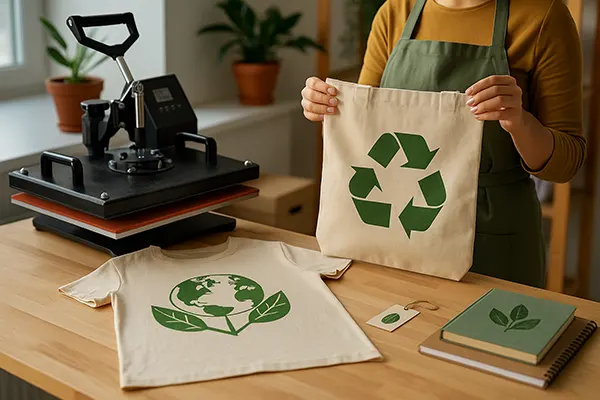
Print-on-Demand Business with ESG-Themed Products
Print-on-demand (POD) has become a powerful way to build an independent income source without the need for large investments or stock storage. In 2025, combining POD with ESG (Environmental, Social, and Governance) principles allows entrepreneurs to create businesses that are both profitable and socially responsible. This approach meets the rising demand for sustainable and ethical products, which has become a central purchasing factor for many consumers.
Embedding ESG Principles into Your POD Strategy
ESG values can be built into a POD business through careful material selection, production ethics, and brand transparency. Choosing organic cotton, recycled fabrics, and water-based inks helps reduce the environmental footprint while appealing to eco-conscious buyers. Such steps are not only ethically sound but also offer a marketing edge in a competitive market.
Responsible sourcing should be matched with fair labour practices. Working with manufacturers that follow international labour standards enhances the brand’s social credibility. Many consumers in 2025 check suppliers’ certifications before buying, so demonstrating ethical production is key to trust-building and long-term loyalty.
Governance is equally important: clear policies on profit distribution, sustainability targets, and accountability build credibility. Regularly publishing updates about your ESG progress can strengthen customer relationships and position your POD brand as a responsible market participant.
Real-World Benefits of ESG Integration
Companies embracing ESG practices in POD are seeing higher customer retention rates. Buyers who share these values are more likely to return, recommend products, and accept premium pricing for sustainable goods. This creates a steady revenue stream rather than one-off purchases.
ESG alignment also improves visibility on marketplaces like Etsy or Redbubble, where eco-friendly and ethical sellers are often featured. This exposure boosts brand awareness without significant marketing costs. It also improves social media engagement as consumers increasingly share ethical purchases.
Additionally, ESG-focused branding attracts potential partnerships with NGOs and sustainability-driven organisations. These collaborations can expand product reach and provide new promotional opportunities, reinforcing the business’s positive public image.
Understanding Market Trends in ESG-Based POD
In 2025, ESG-based POD products are gaining traction across categories like apparel, home décor, and reusable accessories. Research shows that more than 60% of consumers actively look for eco-labels or sustainability information before purchasing, which creates opportunities for responsible brands.
Young audiences, particularly Millennials and Gen Z, are driving this demand. They expect transparency, traceability, and authenticity from the brands they support. POD businesses that align with these values stand out in a saturated market, gaining a long-term competitive advantage.
Global marketplaces are also shifting their algorithms to highlight sustainable products, giving ESG-oriented POD brands more visibility. This means that adopting ESG principles not only aligns with consumer values but also supports discoverability and organic growth.
Consumer Expectations and Behaviour
Modern consumers are informed and sceptical of greenwashing, so they expect concrete evidence of ESG compliance. Providing certifications, production details, and sustainability reports on product pages can significantly increase trust and conversions.
Transparency about supply chains is now a deciding factor for many buyers. Including information about where and how items are made demonstrates honesty and reduces hesitation at the point of purchase, leading to higher checkout rates.
Clear communication about the social causes your brand supports also resonates strongly. For example, donating a percentage of profits to environmental initiatives or local charities can build emotional connections with customers.

Steps to Build a Successful ESG-Themed POD Business
Start by selecting POD suppliers that align with your ESG goals. Prioritise partners who use sustainable materials, provide certifications, and practise ethical labour standards. Vetting suppliers carefully at the beginning ensures your business will stand on a reliable and responsible foundation.
Next, create product lines that communicate ESG values visually and conceptually. This could include designs promoting climate action, social equality, or ethical consumerism. Ensure that your brand story clearly links these values to your mission.
Finally, integrate ESG transparency into marketing. Regularly publish ESG performance updates on your website and social channels, showing measurable progress rather than vague claims. This builds trust, helps differentiate your brand, and shows that you are committed to genuine responsibility.
Long-Term Sustainability and Profitability
Balancing ESG commitment with profitability is achievable when sustainability is treated as a core business value rather than a side campaign. Customers reward consistent action with loyalty, which stabilises revenue and reduces marketing costs over time.
Adopting ESG practices also makes it easier to comply with tightening regulations on sustainability and ethical production. Being proactive reduces risk and protects your business from potential fines or reputational damage.
Ultimately, an ESG-themed POD business can scale successfully if it combines ethical practices, clear communication, and continuous innovation. This approach ensures long-term relevance and positions the brand as a trusted choice in the evolving 2025 marketplace.



